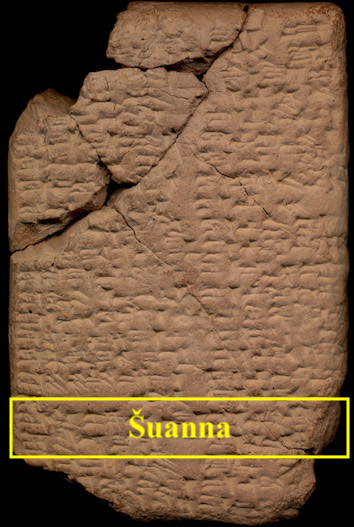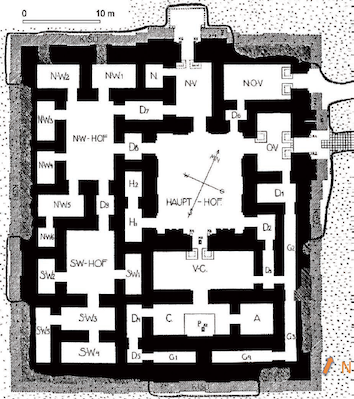Ešasurra (temple of Išhara at Babylon)

According to Tablet IV of the scholarly compendium Tintir = Babylon, Ešasurra, the temple of the mother-goddess Išhara, was one of the two temples situated in the Šuanna district of East Babylon; this information is confirmed from Neo-Babylonian and Achaemenid business documents. Ešasurra is generally identified with the "Temple Z" excavated by Robert Koldewey in 1901–2 in the area of ancient Babylon known today as west Ischin Aswad or southeast Amran, approximately 130 m west of Ehursagtila (the temple of the god Ninurta).

Names and Spellings
This temple at Babylon went by the Sumerian ceremonial name Ešasurra, which means "House of the Womb." The name is attested in Tintir = Babylon Tablet IV, as well as in Neo-Babylonian (reign of Nebuchadnezzar II) and Achaemenid (reign of Darius I) business documents.
- Written Forms: é-ša-as-su-ru; é-šà-sur-ra; é-šà-tùr; é-šà-tùr-ra.
Known Builders
- Neo-Babylonian (ca. 625–539 BC)
- Nebuchadnezzar II (r. 604–562 BC)
Building History
Few details about the building history of the Išhara temple at Babylon are known. From bricks bearing Akkadian inscriptions that were built into the floors and dais of "Temple Z" (see below), it is certain that the Neo-Babylonian king Nebuchadnezzar II (r. 604–562 BC) worked on Ešasurra. However, those texts provide no information about that ruler's work on the building and do not securely identify Ešasurra as "Temple Z." There is some evidence for earlier and later phases of building (Level 1 and Levels 4–5), but it is unclear if some of these also date to Nebuchadnezzar's reign or to one of his predecessors — perhaps his father Nabopolassar (r. 625–605 BC) or the late Neo-Assyrian king Ashurbanipal (r. 668–ca. 631 BC) — or one of his successors — for example, Nabonidus (r. 555–539 BC), the last native king of Babylon.
Archaeological Remains

Excavation plan of "Temple Z." Image from R. Koldewey, Die Tempel von Babylon und Borsippa, pl. 5.
"Temple Z" was excavated by the Deutsche Orient-Gesellschaft (DOG) in 1901–2 under the direction of Robert Koldewey. Because no foundation documents or bricks identifying the building were discovered in the ruins of this 1,710-m² temple, German archaeologists designated it as "Temple Z." Later on, it was wrongly identified as the temple of the goddess Gula. However, based on information provided by Tintir = Babylon Tablet IV, this building was correctly identified as Ešasurra since that temple was located in the Šuanna district, together with Ehursagtila, a temple excavated in 1901 about 130 m to the east. Although the identification cannot be securely confirmed from the archaeological record, the association of Ešasurra with "Temple Z" is fairly certain. Although the ruins are now covered by earth, the contours of the walls can still be seen.
This small temple measured 40×45 m (1,710 m²) and had thirty-three rooms centered around three courtyards. The most important parts of the temple were the main courtyard (Haupt-Hof), the ante-cella (Room V-C), and the cella (Room C). The foundations and walls were constructed from unbaked bricks. The walls were decorated with white lime-gypsum plaster and black bitumen and were 2.2–2.4 m thick; they are estimated to have been 9 m tall.
The dais in the cella (Room C), as well as several of the floor levels (where they are preserved), were constructed with baked bricks of Nebuchadnezzar II. This provides the name of at least one of the temple's builders. Building Levels 2–3, and possibly also Levels 4–5, date to this king's reign. Level 1 likely pre-dates Nebuchadnezzar's reign and, thus, might date to the time of his father Nabopolassar or that of Ashurbanipal, the last great king of Assyria.
Further Reading
- George, A.R. 1992. Babylonian Topographical Texts (Orientalia Lovaniensia Analecta 40), Leuven, pp. 314–316.
- George, A.R. 1993. House Most High. The Temples of Ancient Mesopotamia (Mesopotamian Civilizations 5), Winona Lake, p. 144 no. 1024.
- Koldewey, R. 1911. Die Tempel von Babylon und Borsippa (Wissenschaftliche Veröffentlichungen der Deutschen Orient-Gesellschaft 15), Leipzig, pp. 18–24 and pl. 5.
- Koldewey, R. 1990. Das wieder erstehende Babylon, fifth edition (edited by B. Hrouda), Munich, pp. 218–221.
- Pedersén, O. 2021. Babylon: The Great City, Münster, pp. 193–196.
Banner image: annotated plan of the ruins in the area of the Šuanna district of East Babylon, including "Temple Z" (left); photograph of the area of the ruins of the cella and ante-cella taken in December 2018 (middle); digital reconstruction of "Temple Z" (right). Image created by Jamie Novotny from Koldewey, Das wieder erstehende Babylon, fifth edition, fig. 256; and O. Pedersén, Babylon: The Great City, p. 194 fig. 4.54 and p. 197 fig. 4.58.
Jamie Novotny
Jamie Novotny, 'Ešasurra (temple of Išhara at Babylon)', Babylonian Temples and Monumental Architecture online (BTMAo), The BTMAo Project, a sub-project of MOCCI, [http://oracc.org/btmao/Babylon/TemplesandZiggurat/Eshasurra/]